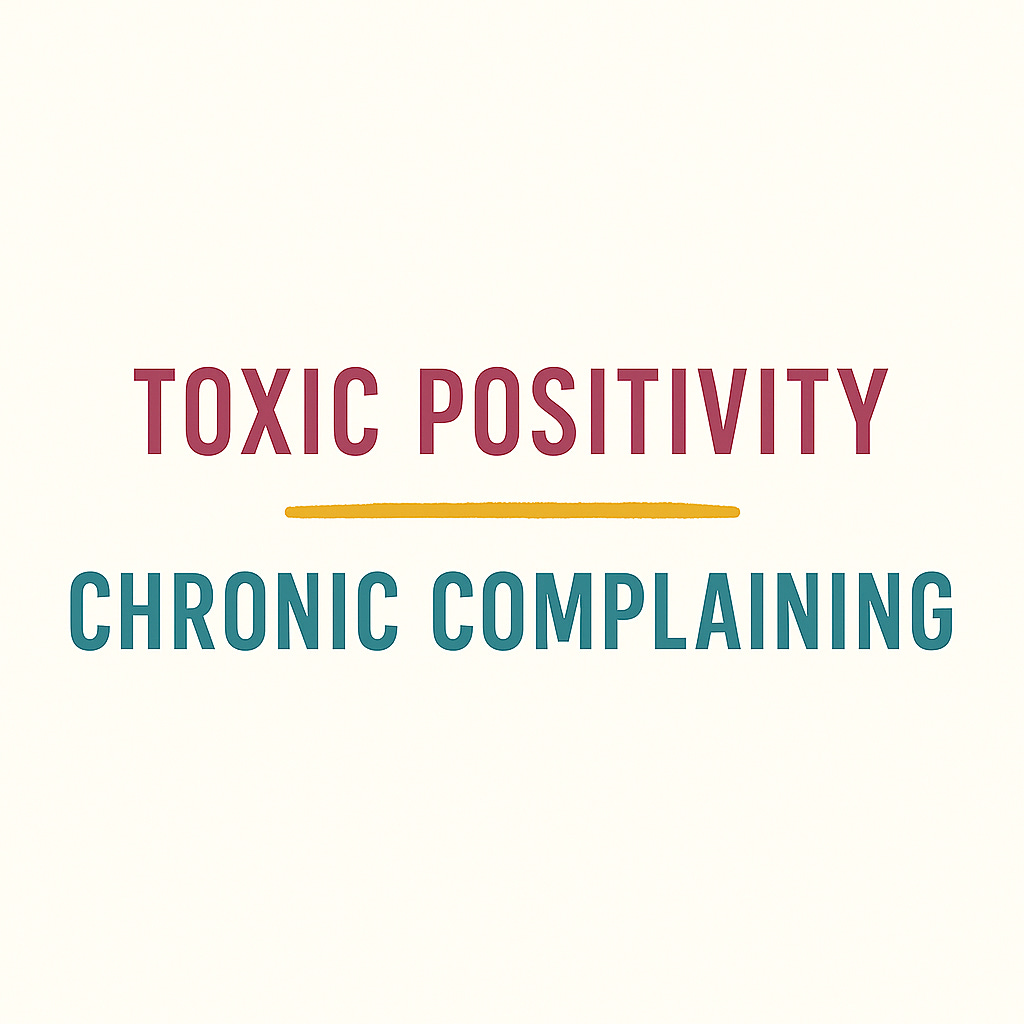Toxic Positivity, Chronic Complaining, and the Magic Middle Ground
Toxic positivity tells us to keep smiling. Chronic complaining tells us life is always hard. Somewhere in between is a much more honest (and helpful) space. Here’s what I’ve learned
There was a time not so long ago when I sat across from my doctor and said, “I don’t know who I am anymore.”
I’d always been the positive one. The everything-is-figureoutable girl. The one who could take a hard moment and flip it into a lesson, a laugh, or a laminated list of things to try next. But the version of me that moved back to Australia a few years ago? She was… different.
She was tired. She was anxious. She’d been through a pandemic separation, major life upheaval, parenting curveballs, and more than one identity crisis. She was a little bit Negative Nancy and a lot confused about how she got there.
My new doctor only knew this version of me, the one after everything changed. And even though things are much brighter now, steadier, softer, more in flow, I can still see how easy it would be to fall into one of two traps:
Pretending everything’s fine when it’s clearly not (hello, toxic positivity), or
Repeating our grievances so often that they start to define us (the complaining loop)
Let’s talk about both.
When Positivity Becomes a Problem
Toxic positivity is that chirpy, relentless “good vibes only” energy that leaves no room for real life. It can sound like:
“Everything happens for a reason!”
“At least it’s not worse”
“Don’t cry, just look on the bright side!”
It’s well-meaning on the surface, but when you're knee-deep in grief, burnout, or something deeply hard, someone insisting you slap a smile on it can feel like emotional shutdown. It says, “Your pain makes me uncomfortable. Let’s not go there.”
For me, the worst part was how I internalised it. I started to judge myself for not being cheerful. For not being “grateful enough.” I’d have a bad day and then feel bad about feeling bad, which is a great way to stay stuck.
The truth is, when we don’t express what’s really going on, when we bypass, suppress or perform our way out of pain, it doesn’t just disappear. It stays lodged in the body. Tension, illness, fatigue, and even chronic conditions can quietly take hold when emotions don’t have a place to land.
What I’ve come to learn is that real resilience doesn’t come from pretending things are okay. It comes from naming what’s hard, feeling it properly, giving it language and air, and when you're ready, sharing it with someone safe. That’s how you move through it.
But... Complaining Can Also Be a Trap
Now let’s flip it. Because while toxic positivity asks us to ignore reality, chronic complaining invites us to live in it on a loop.
There’s power in venting. It can feel like a release valve finally going off. Especially if you’ve spent years keeping it together. But if we keep repeating the same story, our brains start to wire it in as a permanent truth.
We become the person who never catches a break.
Who always has something going wrong.
Who subconsciously scans for proof that life is hard, people suck, and everything is unfair.
Those feelings might be valid, but if we sit in that space too long, we stop looking for the parts that are actually okay. Safe isn’t always the same as helpful.
So What’s the Alternative?
Here’s the middle ground I’ve found most useful:
1. Name it, don’t shame it
Feel what you feel. Rage in the car. Cry in the pantry. Vent to the person who gets it. Just don’t stay there.
2. Ask: what do I need right now?
A nap? A plan? A moment of silence? A therapist? A walk? Let the emotion inform your next step, not paralyse it.
3. Watch the replay loop
Are you telling the same story again and again? Sometimes, the most loving thing we can do is decide we’re done with a narrative. Not because it wasn’t true, but because it no longer fits where we’re heading.
4. Be selectively positive
Not "everything is fine" energy. More like "some things are still okay" energy. Even on the hard days, I can usually find one thing that’s working. That’s enough to shift things slightly.
5. Get curious
You don’t have to fix everything straight away. Sometimes it’s enough to wonder, gently: What is this showing me? What part of me is reacting? What would help next?
If the last few years cracked me open, I’m realising now it wasn’t just to break me down. It was to rebuild something more honest.
I still love a to do list. I still try to find the gold in the midst of the mess. But now, I hold space for the full mess too. When the negative voice creeps back in, I don’t fight her. I listen, then gently remind her that we’re not staying there.
We can tell the truth without getting stuck in it.
We can hold hope without faking happy.
There’s room for both.
Oh, and perfectionism is the devil. It’s never going to be perfect, but nothing is ever permanent.
You may also like…
Four Years Later
Well, hey there! I took a week's break from posting because school holidays and interstate guests have been keeping me busy. Although I have a stack of drafts ready to go, I just felt we both needed a week off <3
Solitude or Connection. How Do You Recharge?
Perimenopause has taught me a lot. Some of it gentle. Some of it like a brick to the head.








